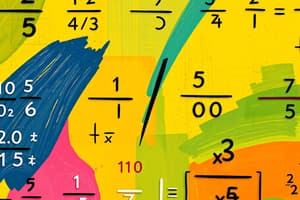Podcast
Questions and Answers
What is the correct way to convert a decimal to a fraction?
What is the correct way to convert a decimal to a fraction?
- Write the decimal as a fraction with the decimal places as the denominator and an appropriate power of 10 as the numerator.
- Multiply the decimal by an appropriate power of 10 to get a whole number and write it as a fraction.
- Write the decimal as a fraction with the decimal places as the numerator and an appropriate power of 10 as the denominator. (correct)
- Divide the decimal by an appropriate power of 10 to get a whole number and write it as a fraction.
How do you divide fractions?
How do you divide fractions?
- Multiply the first fraction by the reciprocal of the second fraction. (correct)
- Multiply the first fraction by the second fraction.
- Subtract the second fraction from the first fraction.
- Add the two fractions together.
When adding or subtracting decimals, what do you do first?
When adding or subtracting decimals, what do you do first?
- Round the decimals to the nearest whole number.
- Divide the decimals by each other.
- Align the decimal points before performing the operation. (correct)
- Multiply the decimals together.
What is the place value of the digit 4 in the decimal number 0.045?
What is the place value of the digit 4 in the decimal number 0.045?
How do you compare decimals?
How do you compare decimals?
What is the definition of a fraction?
What is the definition of a fraction?
What are the three types of fractions?
What are the three types of fractions?
What are equivalent fractions?
What are equivalent fractions?
What is the definition of like fractions?
What is the definition of like fractions?
How can mixed fractions be converted to improper fractions?
How can mixed fractions be converted to improper fractions?
What is the process for adding and subtracting fractions with different denominators?
What is the process for adding and subtracting fractions with different denominators?
What is the process for multiplying fractions?
What is the process for multiplying fractions?
Flashcards are hidden until you start studying
Study Notes
Converting Decimals to Fractions
- To convert a decimal to a fraction, divide the decimal by 1, and then simplify the fraction.
- For example, 0.5 = 5/10 = 1/2.
Dividing Fractions
- To divide fractions, invert the second fraction (i.e., flip the numerator and denominator) and then multiply.
- For example, 1/2 ÷ 3/4 = 1/2 × 4/3 = 4/6 = 2/3.
Adding and Subtracting Decimals
- When adding or subtracting decimals, first align the decimal points, then perform the operation.
Place Value
- The place value of the digit 4 in the decimal number 0.045 is thousandths.
Comparing Decimals
- To compare decimals, compare the digits from left to right, starting from the decimal point.
Fractions
- A fraction is a way to represent a part of a whole.
- The three types of fractions are:
- Proper fractions (numerator < denominator)
- Improper fractions (numerator ≥ denominator)
- Mixed fractions (combination of a whole number and a proper fraction)
Equivalent Fractions
- Equivalent fractions are fractions that have the same value, but different forms.
- For example, 1/2 = 2/4 = 3/6.
Like Fractions
- Like fractions are fractions that have the same denominator.
- For example, 1/4, 2/4, 3/4.
Mixed Fractions to Improper Fractions
- To convert a mixed fraction to an improper fraction, multiply the whole number part by the denominator and add the numerator.
Adding and Subtracting Fractions with Different Denominators
- To add or subtract fractions with different denominators, find the least common multiple (LCM) of the denominators, then convert each fraction to have the LCM as the denominator.
Multiplying Fractions
- To multiply fractions, multiply the numerators and multiply the denominators, then simplify the fraction.
Studying That Suits You
Use AI to generate personalized quizzes and flashcards to suit your learning preferences.




